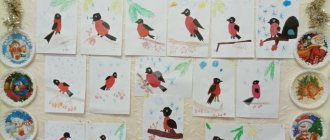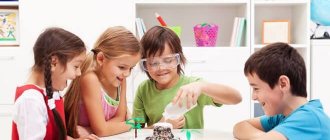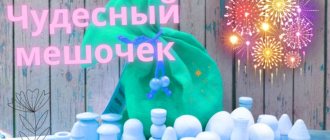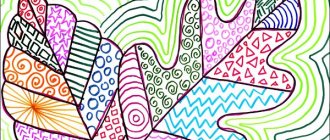Summary of experimental activities in the middle group “The Tale of Paper”
The professor brought us an envelope, what does it contain?Look, we have a fairy tale here, shall we listen?
Far away in a paper country they lived - there were Kartonych (a sheet of cardboard),
Leaflet (sheet of paper) and Fetochka (paper napkin).
And they had a dispute: “Who is more necessary and important among them.” They thought for a long time, and then they decided to find out everything on the journey.
And then on their way they met the Kitty. She wanted to play with the snow, but it was very cold. Friends offered their help to the cat.
Educator: Tell the guys: “How can I help the cat?
Experience: The guys try to make a snowball from three types of paper.
Experiment No. 1 » Let's crumple the paper
«
Invite the children to crumple paper, napkin and cardboard.
-Guys, was it easiest for us to crumple paper, napkin or cardboard? Why ?
Conclusion:
Paper snowball is the best. Cardboard is thick and difficult to fold. The napkin is very soft, tears quickly and does not hold its shape.
Experience No. 2 » Wrinkles, tears
«
— What happened to a piece of paper, cardboard, or napkin when we made a “snowball” out of it?
- What were they like before?
Now try to straighten our paper lumps.
— Has our paper become as smooth as it used to be?
You and I learned that paper wrinkles, but... does not straighten, does not smooth out.
I’ll tell you a secret, the paper can also rustle. Try to crumple the piece of paper and repeat after me the magic words: shi-shi-shi-paper rustle!
Listen now - is it rustling?
- Take our lump from a napkin and pull it in different directions.
- What happened?
- Was it difficult for you to tear the napkin?
Repeat with cardboard and paper.
- What did you do with the leaf?
Tell me, what was easier for you to tear cardboard, paper or napkin? Why?
Conclusion:
This means that thin paper breaks easily, it is not durable. Cardboard is durable and hard to tear.
The kitten said thank you. . Leaflet was proud that he helped.
The friends set off further on their journey, and they met a fox. She wants to drink from the stream, but does not know what to pour the water into.
Educator: Tell the guys: “How can I help the fox?
Guys, we can make a cup out of paper or a napkin or cardboard, but we need to find out which of this material can hold water better.
- Guys, what kind of water do we have, tell us about it?
-That’s right guys, the water is wet and that’s why you and I will now conduct an experiment and find out what kind of paper you have
It won't get wet for a long time.
Experiment No. 3 “Wet the paper”
Invite the children to wet the paper, napkin and cardboard.
Conclusion:
: A cardboard cup is the most convenient, thick, and does not let water through quickly. A glass made from a napkin and paper is not suitable, it gets wet quickly and leaks water.
The fox drank some water and said thank you and ran off into the forest. Kartonich is arrogant!
The friends set off further on their journey. They see a butterfly sitting on a stump and crying loudly, and its wings are stained with dirt. And because of this, she cannot take off, and the houses are already waiting for her.
Educator: Tell the guys: “How can you help a butterfly? (wipe the wings).
Experiment No. 3 “Let’s get some water wet”
Invite the children to wipe the stains on the table with paper, cardboard and a napkin.
- Guys, what was the most convenient way for you to wipe off the dirt? Why?
Conclusion
: The napkin is soft, wrinkles easily and wipes and absorbs better. Cardboard is rough and hard to wrinkle. Paper is less rough, but it is also inconvenient to wipe the table surface with.
Fetochka helped the butterfly put its wings in order. The butterfly thanked her and flew home. And Fetochka became proud, she is the most important.
The friends walked and walked through the mountains and forests, but they were never able to find out: “Which of them is the most necessary and important.” They walked, they walked, and met Professor Shar Sharych. He invited them to visit us. So that we help them. Let the children tell them why they are all very necessary and important to us.
Card index of experiments with paper
“Card index of experiments with paper”
Completed by teacher: Bondareva A.S.
Now we will find out what kind of paper there is. Pick up the paper that is lying on your tables, touch it.
What can you say about her, what is she like? Paper is very important in the life of every person. Children should read books carefully, not wrinkle or tear the pages, and then they will last a very long time. But we will now find out what properties paper has and for this we will conduct a series of experiments:
Experiment “The paper gets wet”
Let's take a bowl of water and put in it first a napkin, and then a notebook sheet. First the napkin got wet, and then so did the notebook sheet. This means the paper gets wet.
Experiment "Paper is torn"
Try tearing a plastic bag and now paper with your hands, and we succeeded. This means the paper tears well.
Experiment “Paper is wrinkled”
Try crumpling a piece of fabric and a piece of paper with your hand. The fabric straightened out, but the paper remained wrinkled. So it wrinkles well.
Experience “Traces remain on paper”
Now take a cotton swab, dip it in vegetable oil and run it across the paper. Yes, we see a greasy mark on the paper. Traces of oil, dirt, pencil, paint, pen, etc. remain on the paper.
"The paper is burning" experiment
Now I’ll take a wad of crumpled paper and show you a very dangerous experiment. I'll set this wad of paper on fire. The paper burned very quickly. This means that it burns, and this threatens a fire, so children should not take matches.
Experiment “Paper Makes Sounds”
Let's take pieces of paper from the table and do the "Washing clothes" movements. The paper rustles and creaks. This means she can make sounds.
Experiment “Experiment with paper and a glass of water”
- Have your child fill the glass with water. Do not fill the glass completely, leave some air. Ask your child to sketch a glass of water, noting where the water is and where the air is.
- Next, cut out a paper square slightly larger than the top edge of the glass. Let the child write down his hypothesis in a notebook about what will happen to the water in the glass and the paper upside down.
- Help your child cover the glass with a square, press it tightly with his hand and turn it over very carefully. Hold the paper with your hand for a while - then slowly release it.
Have your child draw a picture of an upside down glass and label it as water, air, and paper. What's happening? Ask your child why he thinks this is happening? Let him write down in his notebook whether his hypothesis was correct and what happened to the glass. Try to do this experiment with a different type of paper and a different glass, or heat the water, what will change? Conclusion:
The explanation for this fact is quite simple: the air presses on the “lid” from the bottom up with greater force than the water in the glass.
Experiment “Paper Capillarity”
A strip is cut from a napkin. Its width should be three or four centimeters. Along the entire width of the strip, in one row, you need to draw squares or circles (optional) of different colors. The glass should be filled halfway with water. One end of the painted strip should be hooked onto the edge of the glass, and the other end should be lowered into the water. Then you just need to observe. The water rises up the strip and “paints a picture.” This is an illustration of the capillary effect. Due to the porous structure of the napkin (it is made of cellulose), the liquid easily rises up and blurs the design.
Experience “Study of paper cutting properties”
Let your child use scissors to cut the sheets of paper one at a time. (cardboard; writing paper; plain printer paper; colored paper of your favorite color; napkins; notebook; landscape sheet; safety scissors). Are there any differences when cutting? Which paper was easier to cut? More difficult?
Conclusion: It was easiest to cut the thinnest paper, and the most difficult to cut was the thickest.
"Paper Bridge" experience
Have your child place two glasses next to each other and place a piece of paper on top. We have a bridge.
Let's check if our bridge can withstand light objects. First, formulate a hypothesis about whether the bridge will support a small car and write it down in a notebook. Have your child place a small car on the sheet. What's happening? Why did the bridge collapse? Write down the result of the first experiment in a notebook. Is the result different from your hypothesis? What are you thinking now? Ask your child these questions. Now ask your researcher to conduct a second experiment. Have your tester fold the second sheet into an accordion shape. Formulate a hypothesis again and write it down in your notebook. Repeat the experiment.
Experiment “How to transfer peas using a sheet of paper”
Listen to all options. It’s interesting when there are suggestions to fold the sheet into an envelope, make a “cap” out of the sheet, raise the corners of the sheet, fold the piece of paper like an accordion, or simply bend it in half. Let the children move the peas from point A to point B in different ways. The one with the most peas left at the finish line wins.
Conclusion: Which transfer method left the most peas? Which method was the most original? Which way did the children speak most often?
Experience “Making a paper lantern”
- We will use several colored leaves. Let the child choose the color for the future flashlight. Lanterns made from paper in contrasting colors look the brightest.
- Prepare two sheets of colored paper. Have your child use safety scissors to cut out two different colored rectangles. The first measures 7x13 cm, and the second - 9.5x13 cm. The smaller rectangle will become the inner cylinder, and the larger one will become its bright decoration.
- Making a cylinder: Help your child roll the rectangle into a tube and seal the edges with glue.
- Decorate the cylinder: fold the paper in half along the longer side. Using a pencil and a ruler, draw lines for future cuts every 0.5 cm. Do not draw 1 cm to the edge. Let your little student cut the sheet along the lines, also not reaching 1 cm to the edge. Count how many stripes you have.
- Connecting: Help your child glue the cut paper to the cylinder.
- Making a handle for a flashlight: to do this, cut out a thin strip with your child and glue it to the top of the cylinder.
- Your flashlight is ready!
Experience "The best tool for writing letters with ink"
- Dip a nail in ink or food coloring. Take a nail in your hands and draw a straight line on the sheet from right to left. When you reach the edge, start drawing a new line, now from left to right. Continue until you reach the bottom of the page. Was it easy to use a nail as a writing object?
- Repeat the same steps, but this time use a toothpick to apply the ink or food coloring.
- Cut the drinking straw at an angle. Repeat the same process.
- Repeat the same process using a fountain pen.
- Now, using each of the above accessories, try drawing circles. Record your observations.
"Secret Drawing" Experience
- Help the children measure out 14 tablespoons of baking soda and 4 tablespoons of water. Mix and create a "secret mixture".
- Prepare the sheets and have students dip a cotton ball into the mixture.
- Let the children draw their own invisible pictures or write a message. Let the “secret paint” dry completely.
- Then use watercolor paints and apply them over the entire area of the sheet to reveal the secret designs!
Experiment “Coloring paper with coffee”
- Drawing coffee on paper is a fun activity. Place two teaspoons of ground coffee in a bowl and mix with water. Leave it for a while. The longer the grounds remain in the water, the darker the “paint” will be. Fresh coffee grounds help bring out different shades of color
- Let the child draw any picture he wishes. It could be a house, an animal or something abstract. Then you need to outline the drawing with a white pastel pencil. Press down firmly on the pencil and draw the lines your child made. The wax contained in pastel pencils will resist the effects of coffee and preserve the drawing.
- Using a brush, apply coffee “paint” to the entire surface of the sheet. It's okay if grains of coffee on paper are noticeable.
- Leave the drawing for a while until it dries.
- Let your child re-paint the pattern on the parts of the painting that he wants to make darker. Explain to your student that applying paint over the painted areas will create a darker shade.
- Strain the remaining coffee "color". Then the child must apply the thickener to the surface of the drawing using his fingers.
- Lay the sheet on a horizontal surface until it dries. It's okay if the coffee grounds fall off in some places. Now you have a nice grainy design with the image underneath the top layer!
Experience "Smoothness"
We took different sheets of paper and noticed that it was mostly smooth. Smoothness characterizes the condition of the paper surface and determines its appearance - rough paper, as a rule, is unattractive in appearance (with the exception of velvet)
Smoothness is important for writing papers, for printing papers, and also when gluing paper.
Experience "Prosvet"
As a result of the experiment, we took two sheets of paper: thick and thin, put it on the picture and saw that the thin paper showed through the picture. The property of thin paper is translucency. Transparency is used in medicine, drawing, and architecture.
Experience "Flowers on the Water"
We cut out flowers from paper and bend their petals, lower the flowers into the water and watch: the flowers bloom before our eyes.
This happens because paper is porous and water penetrates into the smallest empty spaces between the fibers and fills them. The paper swells, the folds straighten out, and the flower blooms.
Copy paper. Lesson notes on experimental activities (senior group)
Summary of the lesson on the experimental activity “Copy paper” Senior group Goal: To promote children’s understanding of the properties of carbon paper; Develop the ability to examine objects from different angles; Select material, continue the course of activity to obtain the desired result. Objectives: To introduce children to the properties of carbon paper
through experience; Develop the ability to organize your activities; Foster a sense of mutual assistance. Progress of the lesson. Educator: Guys, Dunno from Sunny City turned to us for help. In his letter, he writes that he has a lot of friends and he wants to invite everyone to his birthday. You need a lot of invitations and he won’t be able to draw for everyone. Let's help him. How can we invite friends? (call, send a telegram, an invitation card indicating the date, time, place). Educator: We don’t know how to write, but we need to make a lot of invitations and quickly. The guys who you wanted to invite (children's answers). Educator: But this will take a lot of time. How can we make it so that we can do a lot at once (children’s answers). Educator: There is magic paper with which you can draw several identical invitations, i.e. copy. This paper is called carbon paper. What is the name of this paper? (children's answers). Physical exercise. Let's raise our hands up - once above the nose, above the eyes. Keep your arms straight up, don't swing. don't tremble. Three - put your hands down, Stand still, don’t move around. Up one, two, three, four, down! We repeat, don’t be lazy! We will make turns. Do everything willingly. One - turn left, Two - now vice versa. So, without any haste, Repeat 8 times Educator: Let’s start the experiment. You have white paper, carbon paper, a paper clip, and pencils. Let's pick up carbon paper and study it. What is she like? Is it the same? Children's answers. Educator: One side is greasy with paint, the other is matte. Which side do you think should be used to place the copy on the sheet of paper on which the drawing is being transferred? Why? We need to get a copy, we will write on the matte side, and the paint on the bold side will be printed on the white sheet. The teacher shows. Educator: And if you need to make 3 copies, how many sheets should you take? You need to take 2 sheets of copy paper and 3 white sheets, i.e. there is always 1 more white sheet. To make the drawing clearly visible and have more copies, you need to press harder on the pencil. Now, using carbon paper, we will draw a lot of invitations. To do this, you have two sheets of white paper and one sheet of carbon paper. Place a white sheet, carbon paper on top, and another white sheet. Draw any design on the white top sheet. The children get to work. After finishing, consider what happened. Pay attention to who got two invitations, who got one on both sides. Children conclude that they need to take one more white sheet. At the end of the lesson, children exchange impressions:
- I am glad that I was able to help and make invitations.
- I was surprised that there were several postcards at once.
- It was very interesting to me.
- I was surprised when the copies turned out.
Let's take a blank invitation and color it. Let's draw conclusions about the benefits of carbon paper. Do you need it? Using carbon paper, you can make more copies in less time. Dunno expresses gratitude to you, now he can invite all his friends to the holiday.




